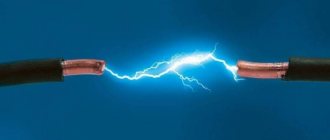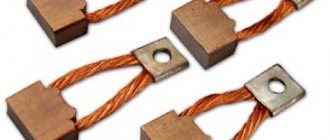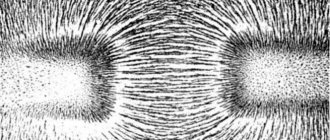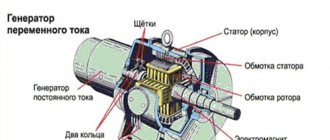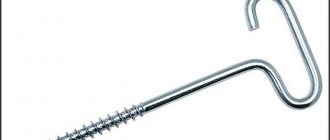Home > Theory > Permanent magnets
There are two main types of magnets: permanent and electromagnets. You can determine what a permanent magnet is based on its main properties. A permanent magnet gets its name because its magnetism is always “on.” It generates its own magnetic field, unlike an electromagnet, which is made of wire wrapped around an iron core and requires current to flow to create a magnetic field.
Permanent magnet
History of the study of magnetic properties
Centuries ago, people discovered that some types of rocks have an original property: they are attracted to iron objects. Mention of magnetite is found in ancient historical chronicles: more than two thousand years ago in European and much earlier in East Asian. At first it was regarded as a curious object.
Later, magnetite was used for navigation, finding that it tends to occupy a certain position when given the freedom to rotate. Scientific research carried out by P. Peregrine in the 13th century showed that steel could acquire these characteristics after being rubbed with magnetite.
Magnetized objects had two poles: “north” and “south,” relative to the Earth’s magnetic field. As Peregrine discovered, isolating one of the poles was not possible by cutting a fragment of magnetite in two - each individual fragment ended up with its own pair of poles.
In accordance with today's concepts, the magnetic field of permanent magnets is the resulting orientation of electrons in a single direction. Only some types of materials interact with magnetic fields; a much smaller number of them are capable of maintaining a constant magnetic field.
Magnet in the past
More than 2000 years ago, the ancient Chinese knew about magnets, at least that this phenomenon could be used to choose a direction when traveling. That is, they came up with a compass. Philosophers in ancient Greece, curious people, collecting various amazing facts, encountered magnets in the vicinity of the city of Magnessa in Asia Minor. There they discovered strange stones that could attract iron. At that time, this was no less amazing than aliens could become in our time.
It seemed even more surprising that magnets do not attract all metals, but only iron, and iron itself can become a magnet, although not so strong. We can say that the magnet attracted not only iron, but also the curiosity of scientists, and greatly moved forward such a science as physics. Thales of Miletus wrote about the “soul of the magnet”, and the Roman Titus Lucretius Carus wrote about the “raging movement of iron filings and rings” in his essay On the Nature of Things. He could already notice the presence of two poles of the magnet, which later, when sailors began to use the compass, were named after the cardinal points.
What is a magnet? In simple words. A magnetic field
Properties of permanent magnets
Powerful magnets
The main properties of permanent magnets and the field they create are:
- the existence of two poles;
- opposite poles attract, and like poles repel (like positive and negative charges);
- magnetic force imperceptibly spreads in space and passes through objects (paper, wood);
- An increase in MF intensity is observed near the poles.
Interaction of magnetic poles
Permanent magnets support the MP without external assistance. Depending on their magnetic properties, materials are divided into main types:
- ferromagnets – easily magnetized;
- paramagnetic materials – are magnetized with great difficulty;
- Diamagnets - tend to reflect external magnetic fields by magnetizing in the opposite direction.
Important! Soft magnetic materials such as steel conduct magnetism when attached to a magnet, but this stops when it is removed. Permanent magnets are made from hard magnetic materials.
Magnetotherapy
Physiotherapy with a magnet is often used. What it is? This procedure is called magnetic therapy and is carried out for therapeutic purposes. The effect of this method is to influence the patient's body using magnetic fields under low-frequency alternating or direct current. This treatment method helps get rid of many diseases, relieve pain, strengthen the immune system, and improve blood flow.
It is believed that diseases are caused by disturbances in the human magnetic field. Thanks to physiotherapy, the body returns to normal and the general condition improves.
From this article you learned what a magnet is, and also studied its properties and applications.
How does a permanent magnet work?
His work deals with atomic structure. All ferromagnets create a natural, albeit weak, magnetic field, thanks to the electrons surrounding the nuclei of atoms. These groups of atoms are able to orient themselves in the same direction and are called magnetic domains. Each domain has two poles: north and south. When a ferromagnetic material is not magnetized, its regions are oriented in random directions, and their magnetic fields cancel each other out.
To create permanent magnets, ferromagnets are heated at very high temperatures and exposed to strong external magnetic fields. This leads to the fact that individual magnetic domains inside the material begin to orient themselves in the direction of the external magnetic field until all domains are aligned, reaching the point of magnetic saturation. The material is then cooled and the aligned domains are locked into position. Once the external MF is removed, hard magnetic materials will retain most of their domains, creating a permanent magnet.
Production of permanent magnets
Applications of Ferrite Magnets
Ferrites are considered the most popular permanent magnets. Thanks to strontium included in the composition, the material does not corrode. So what is a ferrite magnet? Where is it used? This alloy is quite fragile. That's why it is also called ceramic. Ferrite magnets are used in automotive and industrial applications. It is used in various equipment and electrical appliances, as well as household installations, generators, and acoustic systems. In automobile manufacturing, magnets are used in cooling systems, window lifters, and fans.
The purpose of ferrite is to protect equipment from external interference and prevent damage to the signal received via the cable. Thanks to this property, magnets are used in the production of navigators, monitors, printers and other equipment where it is important to obtain a clean signal or image.
Characteristics of permanent magnet
- Magnetic force is characterized by residual magnetic induction. Designated Br. This is the force that remains after the disappearance of the external MP. Measured in tests (T) or gauss (G);
- Coercivity or resistance to demagnetization - Ns. Measured in A/m. Shows what the external MF intensity should be in order to demagnetize the material;
- Maximum energy – BHmax. Calculated by multiplying the remanent magnetic force Br and coercivity Hc. Measured in MGSE (megaussersted);
- Temperature coefficient of residual magnetic force – Тс of Br. Characterizes the dependence of Br on the temperature value;
- Tmax – the highest temperature value, upon reaching which permanent magnets lose their properties with the possibility of reverse recovery;
- Tcur is the highest temperature value at which the magnetic material irreversibly loses its properties. This indicator is called the Curie temperature.
Magnetic flux formula
Individual magnet characteristics change depending on temperature. At different temperatures, different types of magnetic materials perform differently.
Important! All permanent magnets lose a percentage of their magnetism as the temperature rises, but at different rates depending on their type.
Safety precautions when working with strong magnets
Improper handling of powerful magnets can result in personal injury and life-threatening damage. When attracted to each other, they move with great acceleration and can pinch fingers or make a dent on an easily damaged surface. Neodymium products are very fragile, and when struck or dropped, sharp fragments break off. Never attempt to split, cut or drill into them. Drilling products can easily ignite. Magnets affect the operation of some devices, magnetic media, and pacemakers. Do not place them near credit cards, telephones, electronic devices, mechanical watches, CRT monitors, televisions, floppy disks, or cassette tapes. Keep them out of the reach of children (!).
Types of permanent magnets
Generator with neodymium magnets
There are five types of permanent magnets, each of which is manufactured differently using materials with different properties:
- alnico;
- ferrites;
- rare earth SmCo based on cobalt and samarium;
- neodymium;
- polymer.
Alnico
These are permanent magnets consisting primarily of a combination of aluminum, nickel and cobalt, but may also include copper, iron and titanium. Due to the properties of alnico magnets, they can operate at the highest temperatures while retaining their magnetism, but they demagnetize more easily than ferrite or rare earth SmCo. They were the first mass-produced permanent magnets, replacing magnetized metals and expensive electromagnets.
Magnets in electric motors
Application:
- electric motors;
- heat treatment;
- bearings;
- aerospace vehicles;
- military equipment;
- high temperature loading and unloading equipment;
- microphones.
Ferrites
To make ferrite magnets, also known as ceramic, strontium carbonate and iron oxide are used in a ratio of 10/90. Both materials are abundant and economically available.
Due to their low production costs, resistance to heat (up to 250°C) and corrosion, ferrite magnets are one of the most popular magnets for everyday use. They have greater internal coercivity than alnico, but less magnetic strength than their neodymium counterparts.
Application:
- sound speakers;
- security systems;
- large plate magnets for removing iron contamination from process lines;
- electric motors and generators;
- medical instruments;
- lifting magnets;
- marine search magnets;
- devices based on the operation of eddy currents;
- switches and relays;
- brakes
Magnet in sound speaker
Rare Earth SmCo Magnets
Cobalt and samarium magnets operate over a wide temperature range, have high temperature coefficients and high corrosion resistance. This type retains magnetic properties even at temperatures below absolute zero, making them popular for use in cryogenic applications.
Application:
- turbo technology;
- pump couplings;
- wet environments;
- high temperature devices;
- miniature electric racing cars;
- radio-electronic devices for operation in critical conditions.
Neodymium magnets
The strongest existing magnets, consisting of an alloy of neodymium, iron and boron. Thanks to their enormous power, even miniature magnets are effective. This provides versatility of use. Each person is constantly near one of the neodymium magnets. They are, for example, in a smartphone. The manufacture of electric motors, medical equipment, and radio electronics rely on ultra-strong neodymium magnets. Due to their ultra-strength, enormous magnetic force and resistance to demagnetization, samples up to 1 mm are possible.
Neodymium magnets of different shapes
Application:
- hard disks;
- sound-reproducing devices – microphones, acoustic sensors, headphones, loudspeakers;
- prostheses;
- magnetically coupled pumps;
- door closers;
- engines and generators;
- locks on jewelry;
- MRI scanners;
- magnetic therapy;
- ABS sensors in cars;
- lifting equipment;
- magnetic separators;
- reed switches, etc.
Polymer magnets
Flexible magnets contain magnetic particles inside a polymer binder. Used for unique devices where installation of solid analogues is impossible.
Application:
- display advertising – quick fixation and quick removal at exhibitions and events;
- vehicle signs, educational school panels, company logos;
- toys, puzzles and games;
- masking surfaces for painting;
- calendars and magnetic bookmarks;
- window and door seals.
Polymer magnets
Most permanent magnets are brittle and should not be used as structural components. They are made in standard forms: rings, rods, disks, and individual: trapezoids, arcs, etc. Neodymium magnets, due to their high iron content, are susceptible to corrosion, so they are coated with nickel, stainless steel, Teflon, titanium, rubber and other materials.
Use of neodymium magnets
It is worth taking a closer look at what a neodymium magnet is? This is a material that is capable of recording the consumption of water, electricity and gas in meters, and not only. This type of magnet belongs to permanent and rare earth materials. It is resistant to the magnetic fields of other alloys and is not subject to demagnetization.
Neodymium products are used in the medical and industrial industries. Also in domestic conditions they are used for attaching curtains, decorative elements, and souvenirs. They are used in search instruments and electronics.
To extend their service life, magnets of this type are coated with zinc or nickel. In the first case, spraying is more reliable, as it is resistant to aggressive agents and can withstand temperatures above 100°C. The strength of a magnet depends on its shape, size and the amount of neodymium included in the alloy.
